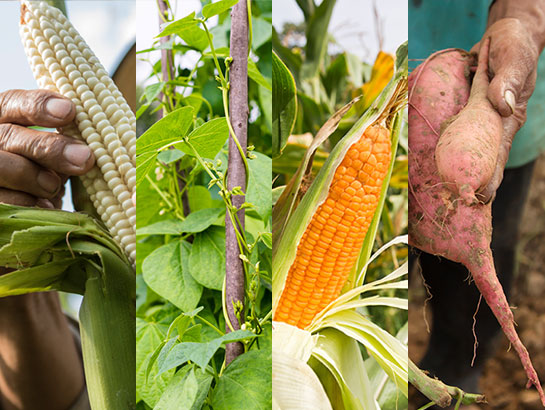The global nutrition community, increasingly focused on holistic approaches to improving diets, is promoting dietary diversification and ensuring that every element of the diet is as nutritious as possible. To support these objectives, HarvestPlus and its partners are leveraging opportunities to introduce more than one type of biofortified crop to a given smallholder farming community, especially when such a “food basket” approach is warranted for nutritional or socio-cultural reasons.
The main objective of introducing multiple biofortified crops to farming households is to provide dietary complementarity and give the farmers a choice based on the staple food preferences in their area. It enables households to acquire multiple essential micronutrients from one food basket.
There is already a robust scientific evidence base for the nutrition and health benefits of individual biofortified crops, and researchers are currently investigating the nutritional interplay when more than one biofortified crop is consumed by the same population group. According to a report from one field project completed in 2018, communities in several regions of Nigeria and Tanzania benefitted in both nutrition and livelihood terms from the introduction of multiple biofortified crops. The project promoted a food basket approach for ending micronutrient malnutrition that included iron-biofortified beans, and vitamin A-biofortified orange sweet potato (OSP), cassava, and maize.
The first ever multiple biofortified food efficacy study (MBFC) began in March 2019, in Andhra Pradesh, southeast India. In India and many other countries, individuals can have multiple micronutrient deficiencies simultaneously. Biofortification holds promise to address these deficiencies concurrently in areas that eat numerous staple crops. Up to 250 young children and their breastfeeding mothers are being randomized into two groups and fed a varied diet six days a week. Meals are made with biofortified zinc wheat, iron pearl millet and vitamin A sweet potato or their non-biofortified conventional counterparts. The feeding study will be completed at the end of 2020, with results anticipated the following year.
HarvestPlus is working with several partners in Africa and Latin America to make multiple biofortified crops available to the same smallholder farming families. Below are some examples so far from implementing this approach:
Zimbabwe: Vitamin A Maize and Iron Beans
John and Sophia Chikumbu of ward 7 in Mutasa district were among the first people in the district to start growing biofortified crops—vitamin A maize followed by high iron beans—after the Livelihood and Food Security Program(LFSP) taught them about the crops’ nutritional benefits.
The LFSP is a Foreign, Commonwealth & Development Office (FCDO)-funded program that is co-managed by the Food and Agriculture Organization (FAO) and Palladium, and implemented by a consortium of local and in international NGOs. HarvestPlus is the LFSP technical partner on biofortification, and leads the program’s efforts to promote the production and consumption of biofortified crops in the country.
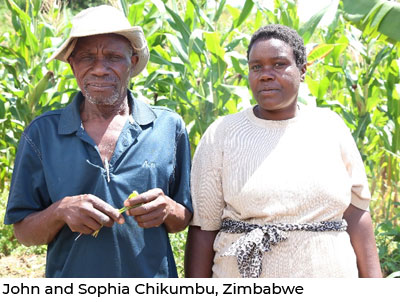
The program found that Zimbabwean farming families are interested in growing more than one biofortified crop as long as the crops are adapted to their area. As farmers become more nutrition-conscious in their farming practices, they have been readily accepting more-recently introduced biofortified varieties such as iron beans. Beans are an important relish and meat substitute in the country that are consumed by people at every income level, but most importantly by the rural and urban poor. Beans are also an important staple item in many institutions including hospitals, boarding schools, colleges, prisons, and orphanages.
The Chikumbus are one of an estimated 300,000 households in the 12 LFSP operating districts who now grow and consume biofortified crops. “As a farming family, we are happy because we are now growing healthy food crops such as orange maize and high iron beans for ourselves,” said Sophia.
“We are now renowned orange maize farmers in this area. I now realize that there are more nutritious staples that we can grow to complement our consumption of maize and that’s why we have dedicated some land to iron bean production,” said John.
The Chikumbu family now grows two orange maize crops in a year in summer and winter. They sell surplus grain to the surrounding community and at Sakubva market, a major horticultural hub located in Mutare. They plan to save all of their iron bean harvest for the family’s consumption so they can enjoy the many benefits of iron in the diet.
Guatemala: Zinc Maize and Iron Beans
Julio Cesar Portillo is a proud grower of biofortified beans and maize in Jutiapa, in eastern Guatemala. At age 55, he works every day on his farm with the support of his nephews and nieces, taking care of the iron bean seed lots and the country’s recently-introduced biofortified maize hybrid with zinc.
Julio was part of the first group of farmers who, with the support of the Institute of Agricultural Science and Technology (ICTA) and HarvestPlus, began working with biofortified crops in Guatemala. Today, Julio is a producer of certified seed (seeds that have been officially released and approved through quality assurance processes), and helps other farmers in his community to become aware of the benefits of biofortified crops.
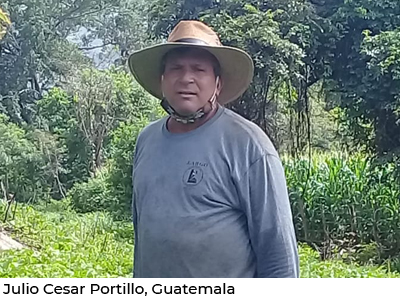
Julio is a member of Atescatel, an agricultural cooperative that is associated with the BioFort Platform, an alliance that promotes biofortified crops in Guatemala and coordinates the actions of various institutions such as HarvestPlus, the NGO Semilla Nueva, the World Food Programme and ICTA.
Atescatel’s link to BioFort made it possible for Julio to begin growing biofortified crops: “Several institutions such as HarvestPlus, ICTA and Semilla Nueva visited us and introduced us to biofortified crops. There I participated in the first trials. Biofortified crops are very good products and most people here in Guatemala eat beans and maize. So these crops are more nourishing for the body,” he said.
Julio is one of the farmers who has been most involved with growing biofortified crops, and for him it is very important to plant both beans and maize because it allows him to generate employment. In any busy season, he is able to hire up to 15 people from his community. In addition, these crops have allowed his six nephews to generate income for their studies, since each one has been assigned a percentage of land to cultivate and produce.
“For me, the [sale] price of biofortified crops is much higher than non-biofortified crops. If I sell traditional maize seed I get paid 1 quetzal (about 13 USD) per kilogram. I get paid 4 quetzals (about 52 USD) for biofortified crops. It gives me a lot of margin.”
To date, seven biofortified varieties of beans, maize, and sweet potato have been released in Guatemala with the support of HarvestPlus, including the world’s first hybrid zinc maize.
Uganda: Iron Beans and Vitamin A Orange Sweet Potato
Justine Baligonzaki is a 40-year-old mother of seven children from Kyabigambire sub-county in Hoima district. She was introduced to growing vitamin A OSP and iron beans in July 2018 by Hoima Caritas Development Organization (HOCADEO), a HarvestPlus implementing partner in Hoima district. Justine benefitted from the trainings in agronomy for OSP and iron beans as well as training in nutrition.
She was interested in the new crops, particularly because of their nutritional benefits, so she often took advantage of extension services from HOCADEO staff, who regularly monitored her gardens. Justine has continued to grow both OSP and iron beans because of the benefits she has seen and experienced from both crops.
Before she adopted OSP and iron beans, Justine’s children were often sick from diseases like diarrhea and they even had skin rashes. “After feeding my children regularly with OSP and iron beans, I started noticing changes in their health. They were not falling sick like they used to, and even the rashes had disappeared”, says Justine.
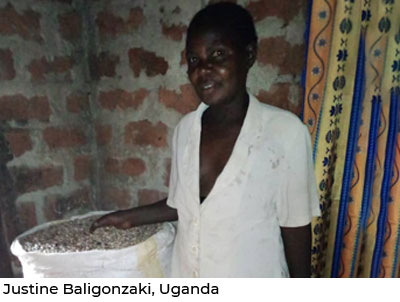
Justine is grateful to HarvestPlus and HOCADEO because she is now able to sell surplus OSP and iron bean harvest and buy other necessities. She has also been able to pay school fees for two school-age children. In a given week, she sells at least two basins of OSP roots at UGX 20,000 (about 5 USD) and sells beans whenever she has a pressing need to do so. “I’m able to buy small household necessities with this weekly money. I can now also say I have a weekly income,” Justine said with a smile.
“I have tried to share the OSP vines and iron beans with my neighbors and other family members that didn’t get these crops so that everyone in my village can benefit,” she added.
Both OSP and iron beans are recommended to the farmers mainly for nutritional reasons: beans provide protein and iron, while sweet potatoes provide carbohydrates and vitamin A.
HarvestPlus works with partners on informing farmer groups about biofortified crops and then supporting them to access the planting material for these crops. Farmers are trained on recommended agronomy and the nutrition benefits, as well as cooking demos on how to prepare dishes for children and mothers.
One challenge faced on Uganda in introducing more than one biofortified crop is the extra time and cost required to provide support to farmers so they can grow these crops, which are usually grown and harvested at different times of the year.
To make it easier to reach more farmers and build up seed supplies, a system of “payback” was adopted whereby some farmers receiving seeds would agree to pay for them by giving back to the partners twice as much seed after harvest.
The HarvestPlus Uganda team realized that payback for the different crops had to be not only handled at different times but also for the beans there was an extra cost of storage of the beans. The group leader or community-based facilitator has to collect and dry beans and keep them for the next season, so that creates an extra cost for beans; in the case of sweet potatoes, the vines remain in the garden of the farmers.
Colombia: Zinc Maize and Iron Beans
In the village of La Meseta, in the rural town of Jamundí in western Colombia, there is a farm called Finca El Edén. The owner, Nolberto Pérez, is a producer of specialty coffee who, after working 12 years in the city as an electronics technician, decided to pack his bags and move here. Today, in addition to coffee, he grows banana, cassava, and biofortified maize and beans, and he is sure that this was the best decision he ever made.
“I come from a farming family. One of my grandparents was a coffee farmer, the other a cattle rancher. My father and mother were raised in the city but I spent time with my grandparents. Since those years I adored the countryside,” said Nolberto, whose farm is about 1,900 meters above sea level.
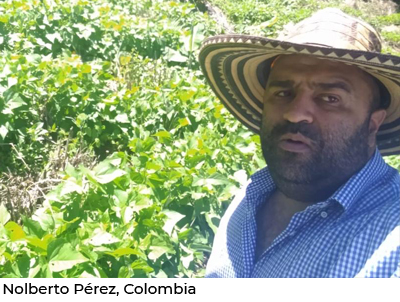
“I live better now than I did before. I only hope I can live my whole life here in the countryside growing nourishing crops for my family,” he said.
In 2019, thanks to a delivery of biofortified seeds that HarvestPlus made to the Jamundí mayor’s office, Nolberto received the iron bean and zinc maize seeds. Since he was a child, his grandparents taught him that it is good to have several crops, so if there is a problem with one of the crops, he can depend on the others for a good harvest. Planting different crops can also help control diseases and pests.
The beans and maize he grows are consumed by his family, and he says that they taste very good in addition to their nutritional benefits. As recommended by HarvestPlus, he also saves some seed from his production for future harvests and to distribute to his neighbors.
Said Nolberto: “With what I have planted, which is two rows, I am able to harvest at least one and a half arrobas (about 12 kg). That can last me at least four months. And in the area there are at least five producers who are planting biofortified crops, since we share the seeds among ourselves. This is very normal in the countryside. The neighbor comes and you say, ‘Have this seed.’ We share seed among ourselves. And in doing so, we share the nutritional value that it provides!”
Malawi: Vitamin A Maize and Iron Beans
In 2018, HarvestPlus Malawi partnered with Ekwendeni Mission Hospital, a private mission hospital located in Mzimba District in the northern part of Malawi. The hospital runs a community-based organization called Ekwendeni HIV/AIDS Program (EHAP), which formed a partnership with HarvestPlus Malawi. The program has introduced vitamin A maize and iron beans to EHAP members, most of whom are living with HIV/AIDS, as an intervention against malnutrition among such people and their immediate family members.
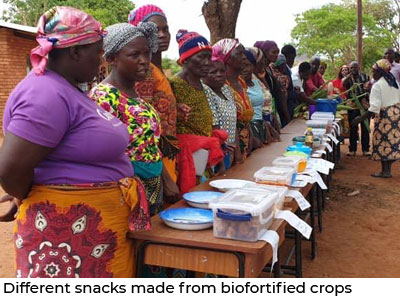
The Ekwendeni area is home to over 50,000 people. As part of the partnership arrangement, HarvestPlus supplied biofortified seeds and fertilizers for a period of two years (two summer and two winter seasons). Sixty-eight hospital clients (33 females and 35 males) were direct beneficiaries of the program, but more than 280 families indirectly benefitted from the program; the direct beneficiaries shared their crops with other members of the community hence spreading the reach to far more vulnerable families.
The ministries of Health, Agriculture and Gender (in particular the Department of Social Welfare and Community Development) were part of the collaboration, working hand in hand with HarvestPlus in disseminating biofortification and nutrition education in the area. The local tribal chiefs also played an important role as they encouraged participation of their communities in the program activities, such as field days, which helped to sensitize farmers on the benefits of producing and consuming biofortified crops.
During the winter 2019 season, 102 members planted 16 demonstration plots for biofortified crops, and in summer 2019, 163 members participated in the program. On their own, beneficiaries managed to produce over 40 metric tons (MT) of vitamin A maize from 10 hectares of cultivated land.
There has been a noticeable increase in the production and consumption of vitamin A maize and iron bean in the area: 16 biofortified crop demonstration plots were established in the 2018/19 season and another 16 in the 2019/2020 growing season. The demand for biofortified seed in the area is growing such that EHAP procured 1 MT of iron bean and maize seeds in 2020 for its members. A maize yield of 4 MT per hectare was achieved by the beneficiaries. The main aim of the program was to enable beneficiary households produce more nutritious food crops to prevent nutrition deficiency-related illnesses.
HarvestPlus now plans to link EHAP directly with seed suppliers so that biofortified seed can be made available in Ekwendeni this season and farming households can maximize their production, and to sustain the program in the area.
Donatten Twizelimana, the Ekwendeni Hospital Administrator, said: “The Hospital continues to register cases related to vitamin A (and other micronutrient) deficiency, hence it is imperative to aggressively continue vitamin A orange maize (production) in the (area) for the benefit of the affected communities.”
There is an evident need to grow more biofortified vitamin A maize and iron bean…to protect our children from conditions related to micronutrient deficiencies,” he added.
